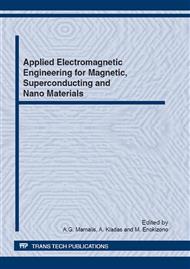p.211
p.219
p.225
p.231
p.237
p.243
p.249
p.255
p.263
Study on Improvement of Transmission Torque for a Surface Permanent Magnet Type Magnetic Gear
Abstract:
Magnetic gears are a force transmitter consisting of permanent magnets. The mechanical input can be transmitted to an output shaft without contact by magnetic forces. The magnetic gears are not worn out because there is no friction. As a result, the running costs such as the maintenance fee can be suppressed and the resources can be saved. However, the transmission torques of the conventional magnetic gears, which have so far been developed, are very low. Besides, new structure models designed for high torque density need a lot of permanent magnets and multi-pole constructions. Those structures are complex and the manufacturing is difficult. In this research, we applied a flux concentration type surface permanent magnet arrangement to a surface permanent magnet type magnetic gear in order to improve the transmission torque and to reduce the amount of permanent magnets. The magnetic flux distribution, the gap flux density and the transmission torque of the developed new models are numerically analyzed by using the two-dimensional finite element method. In this paper, a permanent magnet structure optimized to reduce its amount and influence of the flux concentration type surface permanent magnet arrangement on the gap flux density distribution and transmission torque are reported.
Info:
Periodical:
Pages:
237-242
Citation:
Online since:
June 2012
Price:
Сopyright:
© 2012 Trans Tech Publications Ltd. All Rights Reserved
Share:
Citation:


